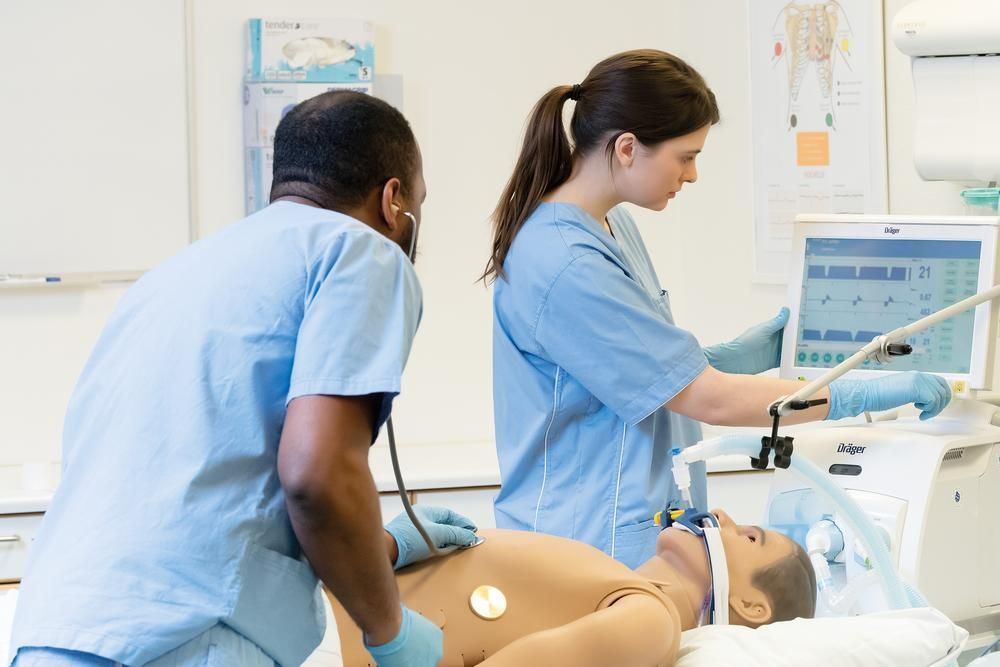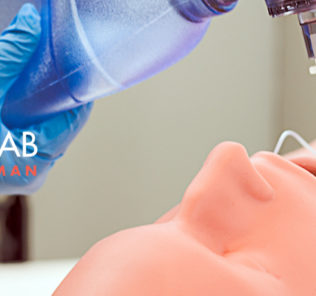Laerdal Introduces SimMan Critical Care
Laerdal Medical, a leader in patient simulation, has partnered with IngMar Medical to provide critical care and respiratory training, which includes basic to advanced ventilation management, in a single high-fidelity patient simulator: SimMan Critical Care. To deliver optimal patient care for life-threatening critical and respiratory conditions, healthcare providers need comprehensive and effective training. Simulation can help current and future clinicians be prepared to care for critically ill patients by providing realistic training opportunities that allow learners to master essential skills and build confidence through deliberate, repetitive practice – without any risk to real patients. This HealthySimulation.com article will discuss Laerdal’s SimMan Critical and how to incorporate the human patient simulator into medical simulation training.
Laerdal Medical is dedicated to the mission of helping save lives through the advancement of simulation-based training in the fields of resuscitation, patient care, and emergency care training. Laerdal products and programs are used by educational institutions, hospitals, Emergency Medical Services (EMS), and the military around the world.
The new SimMan Critical Care, integrated with IngMar’s ASL 5000 technology, is designed to meet the needs and requirements of healthcare students and professionals with a special focus on critical care, respiratory care, and anesthesia while continuing to offer the functionality that the previous SimMan has delivered for two decades, which includes trauma care and emergency medicine.
Sponsored Content:
With IngMar Medical’s technology, healthcare simulation educators can provide hands-on training using a real ventilator! IngMar Medical is the world leader in breathing simulation – a distinction built on a solid history of quality, innovation, and customer service. For over a quarter of a century, the company’s mission has been to help decrease suffering and improve outcomes for patients who rely on respiratory devices. Ingmar Medical does this by providing respiratory simulators and test lungs that are used worldwide to provide hands-on clinician training, test ventilator performance, and accelerate research and development. This is also done to test to ensure the quality and safety of respiratory therapy products, and train clinicians to achieve the highest level of patient care.
https://youtu.be/qefDJwr2SNQ&vq=hd1080
Key features of SimMan Critical Care include:
- Tetherless respiratory function and control within an advanced patient simulator
- Ability to interact with all ventilation modes, including Pressure Support, Adaptive Support, and Proportional Assist Ventilation
- Flexibility to simulate any patient condition, leveraging ASL 5000™ technology integrated within SimMan
- Ability to perform advanced ventilation simulations progressing through transitions of care from pre-hospital to ICU
“We know that critical and respiratory care are complex areas of practice – and that simulation training, especially when conducted realistically in the actual clinical environment, can provide crucial hands-on learning opportunities to help clinicians master these skills and build preparedness using their own equipment,” says Neil Weber, President, Laerdal North America. “We’re excited to release SimMan Critical Care, which facilitates these ‘in situ’ simulations and delivers a training experience that will ultimately empower current and future healthcare providers with the skills and confidence they need to deliver the highest-quality care to every critically ill patient.”
Sponsored Content:
https://youtu.be/qefDJwr2SNQ&vq=hd1080
Sample Respiratory Distress Scenario Using SimMan Critical Care
Providing your learners with comprehensive and effective simulation training can help prepare them to deliver the best possible patient care for life-threatening critical and respiratory conditions. Conducting simulations in situ, or in the actual clinical environment, provides the added benefit of increased realism and ability to practice in your own space, with your own equipment.
Audience: Learners should be in their second or advanced medical-surgical course, nursing course with clinical rotations in critical care or emergency departments. Other learners should be interprofessional team members such as medical students, residents, acute care nurse practitioners, and respiratory therapists.
Objective: The objective of the simulation is to collaborate as an interprofessional team to assess the patient and determine if any ventilator changes or diagnostic testing are required.
Setting: The setting is an acute care hospital in the medical intensive care unit for a patient admitted with acute decompensated heart failure with respiratory distress.
Equipment: The patient would be SimMan Critical Care with physiological monitors. Other equipment required would include a ETT with connected ventilator and EtCO2, IV infusion pumps, indwelling catheter, SCD pumps, and hospital bed.
Patient History: 63 year old patient admitted with history of COPD and heart failure exacerbation. History of type 2 diabetes, COPD, heart failure with ejection fraction of 28%, hypertension, and STEMI requiring cardiac cath with stent placement in the LAD. History of smoking 30 pack years – quit 6 months ago. Patient transported to the emergency department via ambulance with respiratory rate of 28/min labored with wheezing and crackles auscultated bilaterally. O2 saturation 86% on 6 L/min via NC, HR 122/min with PVCs, and BP . Patient given furosemide, 02 50% BiPAP. Admitted to Medical ICU. CXR reveals COPD and cardiomegaly with fluid in bilateral bases. Pt weighs 80 kg.
Call to Action: Patient’s condition continues to deteriorate. Patient intubated due to ABGs and increased respiratory distess. Patient intubated with 7.5 ETT.After intubation, determine ventilator settings and evaluate the patient’s response to the settings.
Ventilation Management: Mode AC 14, TV 560 ml, O2 50%, Peep 5, Peak 25 cmH2O, DP 5 cmH20, Plateau 25 cmH2O, Ratio I/E 1:2, Vte 575 ml. CXR for tube placement, and repeat ABGs 20 minutes after intubation.
Expected Interventions: Consult with Respiratory Therapy and Intensivist to determine ventilator changes, sedation, positioning, diuresis, and CXR interpretation.
Application of SimMan Critical Care to the Scenario: As shown in this example,SimMan Critical Care can increase the immersion and realism of the scenario, collaboration, and critical thinking skills of the learners. When interpreting the assessment and diagnostic findings, SimMan Critical Care would offer realistic ventilator readings and alarms. With other manikins not designed for intubation and ventilation, the ventilator would alarm excessively and provide high reading even when the patient improved. Learners are not able to suspend disbelief with all these ‘false’ findings which would increase their Cognitive Load of learners. Cognitive Load Theory divides learning loads into:
- Intrinsic Load: the complexity of the information being learned and cannot be changed
- Extraneous Load: the distractors to the working memory to process new information which increases the cognitive load
- Germane Load: interest generated by the learning opportunity to increase processing new information which decreases the cognitive load
SimMan Critical Care decreases the extraneous load and increases the germane load which promotes learning. Ventilator and monitor readings are realistic without equipment limitations that cause false alarms. With the excessive ventilation alarms, learners can cause less sensitivity to ventilator alarms. Ventilator alarm fatigue can negatively impact patient care by inadvertently teaching learners to disregard these alarms. The ventilator and scenarios for SimMan Critical Care allows the learners the ability to apply didactic information in a safe environment to increase the germane load and decrease extraneous load. Through realistic teaching and learning for critically-ill respiratory patients, healthcare professionals can transfer clinical thinking into clinical practice for better patient outcomes.
More About Laerdal Medical
Laerdal, a Norwegian-based company, continues to be a pioneer in the industry of medical simulation. Almost every year Laerdal Medical Corporation unveils a new technology that will forever change the face of healthcare simulation. Along with SimMan Critical Care, Laerdal introduced Mama Anne, a birthing simulation, in 2024. Some of Laerdal’s other innovative products have been the SimMan 3G, SimMan ALS, SimBaby, Nursing Anne Simulator, SimPad and Resusci Anne QCPR. Laerdal ensures their product interfaces are intuitive and user-friendly all while providing the maximum in durability and quality.
Learn More About Laerdal’s SimMan Critical Care!
Teresa Gore, PhD, DNP, APRN, FNP-BC, CHSE-A, FSSH, FAAN – Dr. Gore has experience in educating future nurses in the undergraduate and graduate nursing programs. Dr. Gore has a PhD in Adult Education, a DNP as a family nurse practitioner, and a certificate in Simulation Education. Dr. Gore is an innovative, compassionate educator and an expert in the field of healthcare simulation. In 2007l Teresa started her journey in healthcare simulation. She is involved in INACSL and SSH. She is a Past-President of INACSL and is a Certified Healthcare Simulation Educator Advanced (CHSE-A). In 2018, she was inducted as a Fellow in the American Academy of Nursing (FAAN). In 2021, she was inducted as a Fellow in the Society of Simulation in Healthcare Academy (FSSH) and selected as a Visionary Leader University of Alabama at Birmingham School of Nursing Alumni. During her career, Dr. Gore has led in the development and integration of simulation into all undergraduate clinical courses and started an OSCE program for APRN students. Her research interests and scholarly work focus on simulation, online course development and faculty development. She has numerous invited presentations nationally and internationally on simulation topics.
Sponsored Content:

















